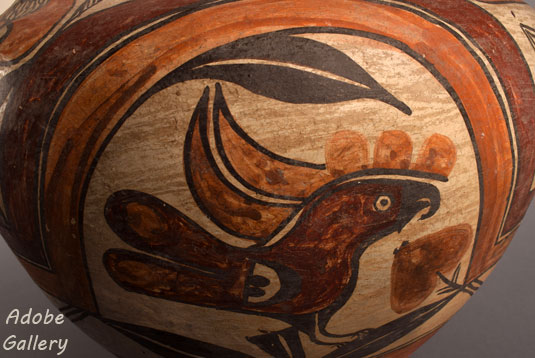Historic Acoma Pueblo Four-Color Polychrome Pottery Jar [SOLD]
+ Add to my watchlist Forward to Friend
- Category: Historic
- Origin: Acoma Pueblo, Haak’u
- Medium: clay, pigment
- Size: 11-1/2" tall x 13" diameter
- Item # 10627 SOLD
Acoma Pueblo Pottery: A Blend of History, Art, and Spirituality
This Acoma Pueblo historic pottery jar, believed to have been crafted between 1890 and 1900, is a testament to the rich cultural heritage of the Native American people. Slightly larger than a typical water jar, its design seamlessly extends from the red underbody to the rim's top, without a dividing line at the shoulder. The design's prominent elements include birds, flowers, and double rainbows—one in a vibrant shade of orange and the other in red. The birds beneath the rainbows are parrots, while those above are straight-beaked birds. Although the latter have not been identified as a specific species, they consistently feature triangular, long, and parted beaks.
In keeping with traditional methods, the jar was coated in a cream slip, and the design was painted in hues of red, yellow, and black. Some colored designs are outlined in black, while others are not. The vessel is adorned with black designs of rain clouds, hachured bars, and split leaves scattered throughout. A wide black band outlines the rim, and a pair of framing lines defines the lower panel. Below these lines, the base is colored with a red slip, overlaid by a wide red band just below the design. The charm of this late 19th-century Acoma olla lies in its somewhat primitive execution, resulting in a beautiful, large-dimensioned jar in good condition.
The terms "prehistoric," "historic," and "utilitarian" are commonly used in relation to pueblo pottery. However, these terms could perhaps be reconsidered with more sensitivity. For instance, the term "prehistoric pottery" has been questioned, as history was being recorded by Native cultures before the arrival of the Spanish explorers. Native cultures recorded their history on animal hides, sandstone canyon walls, and through petroglyphs, pictographs, and verbal traditions. Therefore, recorded history existed before the Spanish arrival.
When pottery is referred to as "utilitarian," it often overlooks the pueblo people's perspective. While pottery may serve utilitarian purposes, it holds deeper meanings for the potters. They do not view their vessels as mere utensils. This is evident in the time and effort potters invest in beautifying a water jar, treating each vessel as a sacred gift from Mother Earth.
The use of the terms "prehistoric," "historic," and "utilitarian" is not necessarily wrong or insensitive, provided we understand them as descriptive terms and acknowledge the significance of vessels at the pueblo, beyond their utilitarian function. As collectors, we admire the beauty of a vessel with its elaborate designs and appreciate the effort put into making it so.
To quote from The Pottery of Acoma Pueblo, referenced below, "Pottery was thought to have intrinsic life-giving powers, and vessels took on the attributes of whatever they held. For instance, water was thought to convey its sacred, vital, life-giving power to the jars that held it. Every vessel was believed to have a spirit, and the lengthy process of producing the vessel was accompanied by age-old prayers and songs. At the conclusion of burial rites, a bowl of water was broken over the grave of the deceased. Canteens filled with water were sometimes buried to give the person a ‘last drink.'" [Lanmon & Harlow, 2013:33-34]
Condition: There was a native piñon pitch repair at the time the jar was purchased in 1984. Subsequently, the pie-shape wedge that had been put back in with piñon pitch was again broken out from the rim. It had to be professionally replaced and was done so without piñon pitch. The pinyon or piñon pine tree group grows in southwestern North America, especially in New Mexico, Colorado, Arizona, and Utah.
Provenance: this Historic Acoma Pueblo Four-Color Polychrome Pottery Jar is from the collection of a resident of Santa Fe
Reference: The Pottery of Acoma Pueblo by Dwight P. Lanmon and Francis H. Harlow, 2013. Museum of New Mexico Press, Santa Fe
Recommended Reading: Pueblo Indian Pottery by Francis Harlow
TAGS: Southwest Indian Pottery, Acoma Pueblo, Historic Pottery

- Category: Historic
- Origin: Acoma Pueblo, Haak’u
- Medium: clay, pigment
- Size: 11-1/2" tall x 13" diameter
- Item # 10627 SOLD
Adobe Gallery Recommended Reading
Adobe Gallery Recommended Items
If you are interested in this item, we would also like to recommend these other related items:



